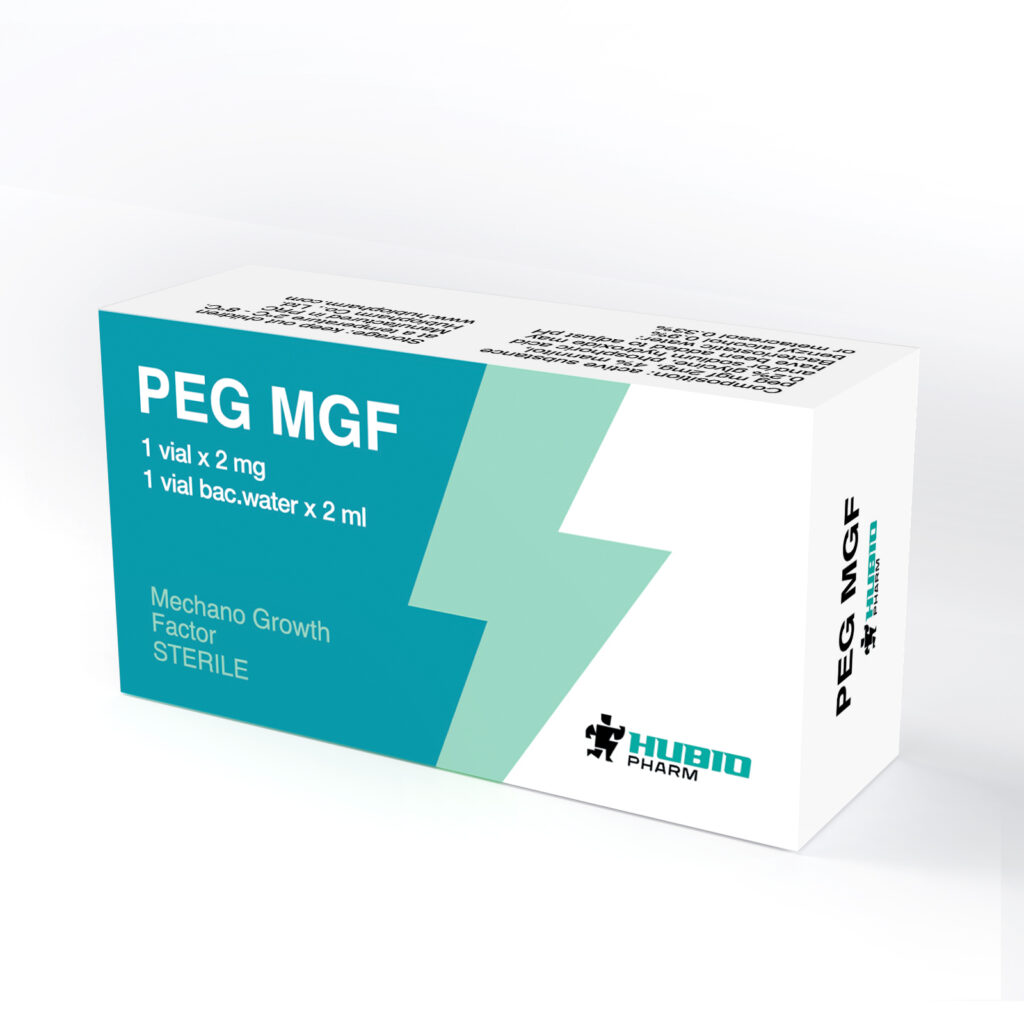- Introduction: The Rise of PEG-MGF in Muscle Regeneration Research
- What Is PEG-MGF?
- Mechanism of Action: How PEG-MGF Supports Muscle Repair
- PEG-MGF vs IGF-1 LR3: Two Powerful Tools in Research
- Benefits of PEG-MGF in Laboratory Research
- Combining PEG-MGF with Other Research Peptides
- PEG-MGF vs Traditional Growth Hormone (GH) Research
- PEG-MGF in Recovery and Injury Research
- Safety and Legal Disclaimer
- How Researchers Use PEG-MGF
- The Future of PEG-MGF Research
- Conclusion
- 🔗 Recommended Research Peptides
Introduction: The Rise of PEG-MGF in Muscle Regeneration Research
Over the last decade, peptide science has advanced rapidly — offering researchers an entirely new toolkit for studying muscle repair, recovery, and tissue regeneration. One of the most promising compounds in this field is PEG-MGF (Pegylated Mechano Growth Factor) — a modified version of the natural MGF peptide, derived from IGF-1 (Insulin-like Growth Factor 1).
PEG-MGF has gained significant attention in the U.S. research community due to its extended half-life and targeted anabolic properties, which make it ideal for studying long-term muscle repair models in vitro and in vivo.
Important: PEG-MGF is strictly for research use only. It is not a drug, supplement, or cosmetic product, and is not approved by the FDA for human or veterinary use.

What Is PEG-MGF?
PEG-MGF, or Pegylated Mechano Growth Factor, is a synthetic analog of MGF, which itself is a splice variant of IGF-1.
MGF is naturally produced in muscle tissue following mechanical stress or injury, signaling the body to start repair and growth processes.
However, the native form of MGF has a very short half-life — just a few minutes. Researchers developed a pegylated version (PEG-MGF) to extend its stability and biological activity, allowing more consistent results in laboratory studies.
Mechanism of Action: How PEG-MGF Supports Muscle Repair
In laboratory studies, PEG-MGF acts by activating satellite cells — specialized stem cells responsible for muscle fiber regeneration.
This leads to:
- Increased muscle cell proliferation
- Faster repair of damaged fibers
- Improved protein synthesis
- Reduced inflammation markers in tissue samples
By attaching a polyethylene glycol (PEG) chain to the molecule, scientists were able to protect MGF from rapid degradation. This modification extends its half-life from minutes to several hours, creating a sustained anabolic signal ideal for muscle repair models.
PEG-MGF vs IGF-1 LR3: Two Powerful Tools in Research
Both PEG-MGF and IGF-1 LR3 are derived from the IGF-1 family, yet their mechanisms and applications differ significantly in scientific research.
| Feature | PEG-MGF | IGF-1 LR3 |
|---|---|---|
| Origin | Splice variant of IGF-1 | Modified IGF-1 analog |
| Half-Life | Extended (hours) via pegylation | Long-acting (20–30 hours) |
| Research Focus | Muscle regeneration and recovery | Muscle hypertrophy and growth |
| Mechanism | Localized repair and satellite cell activation | Systemic anabolic stimulation |
In essence, PEG-MGF focuses on repairing and rebuilding muscle tissue, while IGF-1 LR3 drives growth and hypertrophy.
Many studies examine both compounds in complementary models to better understand muscle physiology.
Benefits of PEG-MGF in Laboratory Research
Scientific and in vitro research has shown that PEG-MGF exhibits several benefits in controlled environments:
- Enhanced muscle recovery after induced mechanical damage.
- Faster myoblast proliferation and differentiation in tissue cultures.
- Reduced inflammatory cytokines, supporting post-injury regeneration.
- Improved muscle cell survival in oxygen-deprived or damaged tissue models.
While these effects are limited to preclinical and research settings, they provide valuable insights into muscle repair mechanisms at a molecular level.
Combining PEG-MGF with Other Research Peptides
In scientific exploration, PEG-MGF is often compared or studied alongside other regenerative compounds such as:
🔹 BPC-157
Known as the Body Protection Compound, BPC-157 is frequently used in research on tendon and ligament repair.
Its ability to promote angiogenesis and collagen formation makes it a valuable peptide in soft tissue healing studies.
🔹 TB-500 (Thymosin Beta-4)
TB-500 plays a crucial role in cell migration and regeneration.
In research, it has shown potential for improving muscle flexibility, mobility, and recovery time after induced injuries.
🔹 IGF-1 LR3
A long-acting analog of IGF-1, IGF-1 LR3 is studied for muscle hypertrophy, insulin signaling, and growth pathways.
When combined in comparative models with PEG-MGF, it allows researchers to analyze acute vs prolonged anabolic effects.
PEG-MGF vs Traditional Growth Hormone (GH) Research
While growth hormone (GH) stimulates the liver to produce IGF-1, its effects are systemic and less targeted.
PEG-MGF, in contrast, provides a localized growth signal directly to damaged muscle tissue in vitro, making it ideal for focused muscle regeneration research.
| Property | Growth Hormone | PEG-MGF |
|---|---|---|
| Action | Systemic GH release | Localized repair |
| Mechanism | IGF-1 pathway | Satellite cell activation |
| Stability | Hormonal cycle dependent | Chemically stable (pegylated) |
| Research Goal | Whole-body growth | Targeted muscle regeneration |
This makes PEG-MGF particularly interesting for sports science and regenerative medicine research models.
PEG-MGF in Recovery and Injury Research
Recent laboratory studies suggest PEG-MGF may play a role in tendon repair, nerve regeneration, and post-injury muscle recovery.
Researchers often study PEG-MGF following mechanical strain or trauma models, observing its influence on:
- Cell migration to injury sites
- Improved blood vessel formation (angiogenesis)
- Faster collagen synthesis
- Restored muscle fiber integrity
When paired with peptides like BPC-157 and TB-500, it forms part of a multi-pathway repair framework, mimicking natural healing responses.
Safety and Legal Disclaimer
⚠️ PEG-MGF is for research use only.
It is not a drug, food, or dietary supplement and has not been evaluated by the FDA.
This compound is not intended to diagnose, treat, cure, or prevent any disease.
Any human or veterinary use, ingestion, or injection is strictly prohibited by law in the United States.
How Researchers Use PEG-MGF
In controlled laboratory environments, PEG-MGF is typically used for:
- In vitro tissue culture experiments
- Comparative growth factor studies
- Post-injury regeneration models
- Molecular signaling pathway research
These studies aim to better understand muscle adaptation, regeneration, and protein synthesis pathways triggered by mechanical stress.
The Future of PEG-MGF Research
The evolution of peptide technology continues to reshape the field of muscle biology and regenerative science.
PEG-MGF’s pegylated design offers a blueprint for longer-lasting, tissue-specific growth factors — paving the way for future breakthroughs in muscle recovery research.
While PEG-MGF remains a research-only compound, its unique structure and regenerative potential ensure it will remain a focus for scientists studying muscle injury and recovery.
Conclusion
PEG-MGF represents the next step in the study of targeted muscle regeneration.
Its ability to extend the lifespan of mechano growth factor activity has made it one of the most valuable compounds for research into muscle repair, hypertrophy, and tissue recovery.
For scientists investigating the complex biology of muscle growth, combining PEG-MGF, IGF-1 LR3, BPC-157, and TB-500 offers a powerful approach to understanding both systemic and localized anabolic mechanisms.




